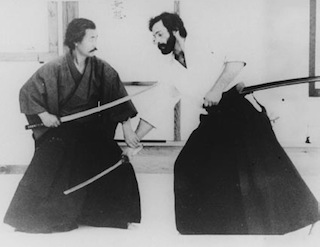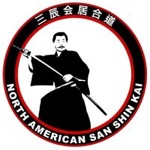History
Created by Jinsuke Shigenobu in 16th century Japan, this unique tradition of defensive swordsmanship (iai) was preserved in an unbroken line of headmasters through the centuries; codified by Nakayama Hakudo (1869 - 1958), and taught worldwide by Mitsuzuka Takeshi Sensei.
Muso Shinden-ryu means an iai school developed according to a divine vision given in a dream.

MU = a vision, a dream
SO = a thought, an idea
SHIN = a god
DEN = A root, an origin
RYU = to flow, a school
I = to exist, to be present
AI = to pull together, to concentrate
DO = a way

Muso Shinden-ryu traces its roots back to Hayashizaki Minamoto no Shigenobu (1546 - 1621). At the age of 21 he went to a Shinto shrine and stayed there for 100 days. According to a vision he received in a dream, he developed the batto-techniques, where one draws the sword and strikes with a single motion. He called his style Shimmei Muso-ryu. This was the first systematized iai school, although similar fast-draw techniques were already used in some of the older schools of kenjutsu.
Later, his students named the style Shin Muso Hayashizaki Ryu. It is believed that Hayashizaki himself stressed the spiritual side of training. There is a temple, Hayashizaki-Iai-Jinja, dedicated to him.
Muso Shinden Ryu as we know it today was born in the early 1900's from this foundation of spiritual practice. Nakayama Hakudo Sensei, a man who had dedicated his life to the study of kendo and iai, came to the conclusion that the classical arts should be reinterpreted and opened to the general public in order for them to survive in the changing world. He reorganized the Muso Shinden-ryu kata using techniques from Omori Ryu and Eishin Ryu. He stressed the importance of sword training, no longer as a just a practical art, but as a method of improving oneself. The sword is no longer a tool for cutting down your enemy, but a tool for cutting your ego as well.

Mitsuzuka Sensei and Sylvain Sensei performing kumitachi
Sensei's Passing
Mitsuzuka Takeshi Sensei, 1926-2008Mitsuzuka Takeshi Sensei lost his battle with cancer on March 6, 2008 at 10:29 AM. Sensei was born on September 15, 1926, to mother Hisayo and father Mounya in Miyagi-ken, Furukawa Shi Sakura no me, the middle son of five. In May of 1943 he entered service in the Japanese navy, at seventeen years of age. After the war, he joined the Tokyo Metropolitan Police, retiring in 1970 with the rank of sergeant. Mitsuzuka Sensei married his wife, Hiroko, in 1953; in 1956 they had their only son, Munehiro.
Mitsuzuka Sensei began his training in Iaido on March 1st, 1955 under the watchful eye of Nakayama Hakudo Sensei. Nakayama Sensei was 85 years old at the time and would only live for another three years. Mitsuzuka Sensei continued his training and modeled the Seiteigata in Gordon Warner and Donn Draeger's well-known book, Japanese Swordsmanship. Later, he founded the San Shin Kai and began teaching Iaido throughout the world.
Listed below are his many accomplishments in budo.
Iai
'56 3/18: 3 dan in Iai from Nakayama Hakudo Sensei (Yushin-kai Iaido Renmei)'59 8/15: 5 dan in Iai from Danzaki Sensei and Omori Sensei (Dai Nippon Iaido Kenshukan)
'67 5/17: Iaido Kyoshi Certificate (All Nippon Kendo Federation)
'79 5/5: 8 dan in Iai (All Nippon Kendo Federation)
Kendo
'72 4/24: 5 dan in Kendo'75 5/8: Kendo Renshi Certificate (All Nippon Kendo Federation)
Jodo
'77 3/15: 5 dan in Jodo from Shimizu Sensei (Shindo Muso-ryu)Judo
'76 11/26: 4 dan in Judo (Kodokan)Other
'61 4/13: Judo Seifukushi (Bone Setter)
San Shin Kai is the federation organized in North America by Mitsuzuka Takeshi Sensei and presently headed by Roger Wehrhahn, Shihan.
North American San Shin Kai offers seminars and training in Muso Shinden-ryu Iaido. To learn more about our organization, please read our Mission Statement. If you are interested in becoming a member, visit our membership page to download an application.
To contact our administrative headquarters, or with questions about San Shin Kai, please email Shihan Roger Wehrhahn at mtteach@ptd.net.
Last updated: August 13, 2011

